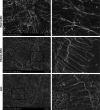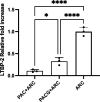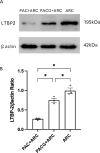Alterations in anterior lens capsule structure and LTBP-2 expression in primary angle-closure glaucoma
- PMID: 39317460
- PMCID: PMC11423727
- DOI: 10.1136/bmjophth-2023-001535
Alterations in anterior lens capsule structure and LTBP-2 expression in primary angle-closure glaucoma
Abstract
Objective: This study investigated the role of latent-transforming growth factor β-binding protein 2 (LTBP-2) in primary angle-closure glaucoma (PACG) by analysing its expression and the ultrastructure of the anterior lens capsule in PACG patients with age-related cataract (ARC).
Methods: Tissue samples of the anterior lens capsule were collected from patients undergoing cataract phacoemulsification surgery. Patients in the experimental group were diagnosed with primary angle-closure (PAC) combined with ARC (PAC+ARC) and PACG combined with ARC (PACG+ARC). The control group consisted of patients with only ARC. The techniques used included scanning electron microscopy, real-time fluorescence quantitative polymerase chain reaction (RT-qPCR), western blotting and immunofluorescence.
Results: Ultrastructural analysis revealed disordered connections in PAC+ARC, loose connections in PACG+ARC and well-ordered connections in ARC. RT-qPCR and western blotting showed significantly lower LTBP-2 mRNA and protein expression in PAC+ARC and PACG+ARC than in ARC, with PAC+ARC having the lowest levels. Immunofluorescence confirmed these findings, showing varying LTBP-2 fluorescence intensities across groups.
Conclusion: The study identified ultrastructural changes in the anterior lens capsules in PACG accompanied by reduced LTBP-2 expression, especially in PAC+ARC patients. This suggests a potential role for LTBP-2 in PACG development, warranting further investigation.
Keywords: Glaucoma.
© Author(s) (or their employer(s)) 2024. Re-use permitted under CC BY-NC. No commercial re-use. See rights and permissions. Published by BMJ.
Conflict of interest statement
Competing interests: None declared.
Figures




Similar articles
-
Factors affecting refractive outcome after cataract surgery in primary angle-closure glaucoma.Clin Exp Ophthalmol. 2016 Nov;44(8):693-700. doi: 10.1111/ceo.12762. Epub 2016 May 10. Clin Exp Ophthalmol. 2016. PMID: 27082207
-
Distinct iris gene expression profiles of primary angle closure glaucoma and primary open angle glaucoma and their interaction with ocular biometric parameters.Clin Exp Ophthalmol. 2016 Nov;44(8):684-692. doi: 10.1111/ceo.12743. Epub 2016 May 2. Clin Exp Ophthalmol. 2016. PMID: 26988898 Free PMC article.
-
Glaucomatous Progression After Lens Extraction in Primary Angle Closure Disease Spectrum.J Glaucoma. 2020 Aug;29(8):711-717. doi: 10.1097/IJG.0000000000001537. J Glaucoma. 2020. PMID: 32366776
-
The role of lens extraction in the current management of primary angle-closure glaucoma.Curr Opin Ophthalmol. 2015 Mar;26(2):128-34. doi: 10.1097/ICU.0000000000000128. Curr Opin Ophthalmol. 2015. PMID: 25565368 Review.
-
Management of Primary Angle-Closure Glaucoma.Asia Pac J Ophthalmol (Phila). 2016 Jan-Feb;5(1):59-62. doi: 10.1097/APO.0000000000000180. Asia Pac J Ophthalmol (Phila). 2016. PMID: 26886121 Review.
References
MeSH terms
Substances
LinkOut - more resources
Full Text Sources
Miscellaneous
